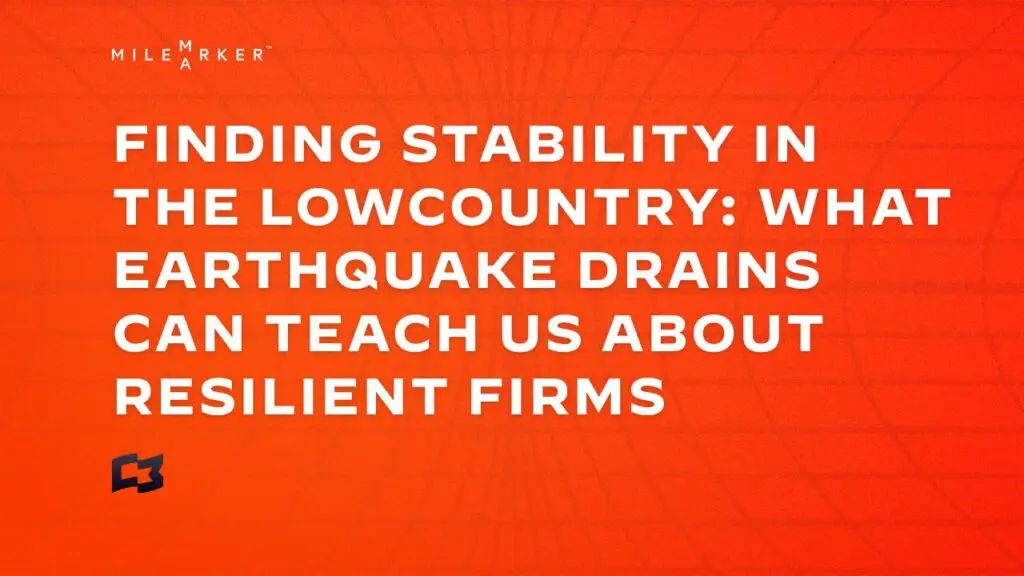Resilient Wealth Systems: Milemarker’s Earthquake Drain Lessons

Charleston, South Carolina.
The charm of the city is undeniable. The food? Widely respected.
But below the cobblestone streets and pastel facades, it’s a different story—one of pluff mud, porous sand, and constant pressure from the tides, storms, and seismic stirrings.
To survive here, the city had to get clever.
Enter: earthquake drains.
Despite the name, they’re not just for earthquakes (though Charleston had a monster in 1886—a magnitude 7.0 that liquefied the ground and cracked buildings across the Southeast).
Earthquake drains are vertical channels that help release groundwater pressure during seismic shifts. But in Charleston, they’ve become multi-taskers—quietly protecting homes and foundations from king tides, stormwater floods, and rising sea levels.
They’re a part of the silent infrastructure keeping everything upright when the world gets shaky. During an earthquake, shaking can cause water trapped in soil pores to increase in pressure, potentially exceeding the soil’s strength. This can lead to the soil behaving like a liquid.
Made of corrugated, perforated plastic pipes wrapped in filter fabric, these drains allow water to flow into the drain while preventing fine soil particles from clogging it. Installed vertically into the ground, a vibrating mandrel is used to create a space for the drain. Then the mandrel is withdrawn, with the drain remaining.
When shaking occurs, the drains provide a pathway for pore water to escape, reducing the excess pore pressure, preventing liquefaction and keeping foundations from damage.
So… what are your earthquake drains?
In the world of wealth management, the ground doesn’t always feel stable either.
One bad quarter in the markets or just plummeting consumer sentiment.
A key advisor leaves.
A merger flops.
Client expectations shift overnight.
The firms that thrive? They’ve built their own earthquake drains:
A real-time dashboard showing where the business is leaking attention or margin
Clear workflows that prevent chaos when someone’s out or something breaks
A decision framework that anchors priorities when things feel upside down
These aren’t glamorous. They won’t show up in your pitch deck.
But like Charleston’s drains, they keep the whole system safe from damage.
Most firms are built on pluff mud
Let’s be honest. The average advisory firm is built on beautiful instability:
– A patchwork of custodians, CRMs, portfolio tools, and billing platforms
– Advisors doing things 7 different ways
– No visibility into the “plumbing” of operations
And then they’re surprised when things sink a little during a market downturn or a tech migration.
You don’t need another shiny tool.
What you need is drainage.
You need systems that release pressure, keep you stable, and make the whole thing scalable.
Does your team even know you have earthquake drains?
This might be the most important part.
Most firm owners have great instincts. They know where the risks are.
But their team? Their clients? Often completely in the dark.
So when pressure builds…
The only person holding the line is you.
It doesn’t have to be that way.
When your team knows where the stress goes…
When clients trust the plan through the storm…
That’s when your business stops being reactive—and starts being resilient.
Charleston’s earthquake drains don’t just handle earthquakes.
They handle everything.
– Tidal swings that rise 6 feet daily
– Hurricanes like Hugo that dump a storm surge of 13 feet
– Nor’easters that turn streets into rivers
– And yes… the occasional tremor
They’re a humble but powerful reminder:
Build for more than the obvious threat.
Plan for the compounded pressures.
Create systems that quietly keep you standing.
Because in Charleston—and in wealth management—the ground will shake.
The tide will rise.
And the firms that stay standing?
They planned for it.
